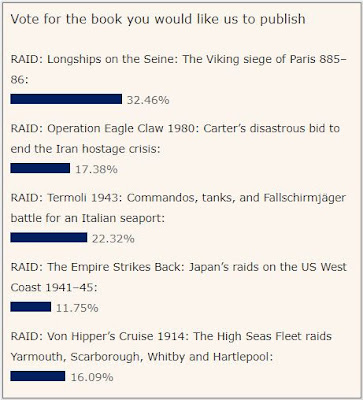20 Oct 2018
October 2018 Book Vote from Osprey Publishing Ltd
Raid Book Vote
Have you voted in our October book vote? With five thrilling new raids to choose from, which will reign supreme and secure victory.
From the vikings in Paris to the Japanese raids on the US, this is an exciting list of possible titles, of which you can read more about by heading to our blog. Also, click here to see which title came top of our September poll.
Longships on the Seine: The Viking siege of Paris 885–86
The Vikings’ siege of Paris in 885–86 was a turning point in the history of both Paris and France. In 885, a year after Charles the Fat was crowned King of the Franks, Danish Vikings sailed up the Seine demanding tribute. The Franks’ refusal prompted the Vikings to lay siege to Paris, which was initially defended by only 200 men under Odo, Count of Paris, and seemingly in a poor state to defend against the Viking warriors in their fleet of hundreds of longships. With siege engines, boats, mines and fire, they attempted to break the Parisian defenders, but failed, and after a year Charles’ army arrived to lift the siege. But Charles then allowed the Vikings to sail upstream against the revolting Burgundians. In this unsatisfactory aftermath the Carolingian empire declined, and Odo – the hero of the siege – was elected king of West Francia, the kingdom that would become modern France.
Operation Eagle Claw 1980: Carter’s disastrous bid to end the Iran hostage crisis
Following months of negotiations after the seizure of the US Embassy in Tehran, President Jimmy Carter ordered the newly formed Delta Force to conduct a raid into Iran to free the hostages. The raid, Operation Eagle Claw, was risky to say the least. US forces would have to fly into the deserts of Iran on C-130s; marry up with carrier-based RH-53D helicopters; fly to hide sites near Tehran; approach the Embassy via trucks; seize the Embassy and rescue the hostages; board the helicopters descending on Tehran; fly to an airbase captured by more US forces; and then fly out on C-141s and to freedom. Unfortunately, and not surprising given the complexity of the mission, things went wrong from the start and when the mission was called off at the refuelling site at Desert One, the resulting collision between aircraft killed eight US personnel. This book would look both at the background to, the planning and the conduct of the raid, and what would have happened if the raid had continued.
Termoli 1943: Commandos, tanks, and Fallschirmjäger battle for an Italian seaport
In October 1943 British commandos landed near the small Italian port of Termoli, surprised the defending garrison and captured the port. They were reinforced by sea and over a light bridge by 78th Division troops, and held off early counterattacks by German Fallschirmjäger. But a German panzer division was en route to the area to drive them into the sea. British engineers raced to build a Bailey bridge that would allow the armour of Eighth Army to come to the aid of the desperate defenders. The battle for Termoli dislodged a superior German force from a valuable seaport, and left the 16th Panzer Division so mauled that it was taken from the front and its commander sacked.
The Empire Strikes Back: Japan’s raids on the US West Coast 1941–45
While the Allies fought to contain Imperial Japan, and then began to roll the empire back towards Tokyo Bay, Japan repeatedly struck targets right on the US West Coast, despite the formidable range difficulties. The IJN used long-range submarines to shell targets on land, conduct raids on shipping, and even launch a small float plane bombing raid. This book would also look at Japan’s incendiary balloon campaign of late World War II – the world’s first intercontinental weapons system.
Von Hipper’s Cruise 1914: The High Seas Fleet raids Yarmouth, Scarborough, Whitby and Hartlepool
In 1914, the High Seas Fleet was banned from attempting a fleet action – but still sought ways to engage the Royal Navy on favourable terms. In November and December, von Hipper’s battlecruiser squadron led a series of raids, mining coastal waters and bombarding coastal towns, their docks and factories. It would provoke the Royal Navy’s battle fleet into action. If successful, it was a chance for von Hipper to even the odds in the North Sea, by finding and engaging a small part of the Grand Fleet, and inflicting disproportionate casualties on it with superior forces. In the confusion at sea, both sides escaped without inflicting or suffering major casualties, but with over a hundred civilians being killed in their homes, the raids shocked Britain, and became a rallying cry for the war.
Osprey Publishing Ltd
Subscribe to:
Post Comments (Atom)

No comments:
Post a Comment